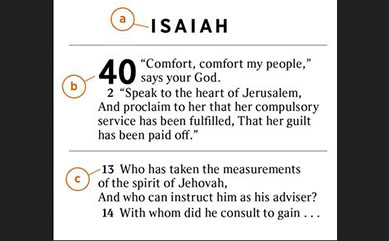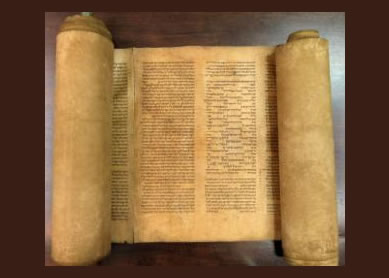These days, it’s not uncommon for Americans to see bumper stickers or placards at sporting events bearing phrases like “John 3:16.” People who display this type of signage are trying to point others toward the Bible. But viewers not already familiar with the Bible may not know what these strings of words and numbers are meant to accomplish—telling people where to look inside the Bible.
Jewish and Christian Bibles are actually anthologies of shorter %%writings called “books.” Bound volumes gathering these books together as a unit, known as codices, began to appear in the second century C.E. Before then the books of the Bible existed as individual scrolls.
Early on, Jewish scribes felt a need to divide these books into smaller pieces. Some biblical manuscripts among the Dead Sea Scrolls (third century B.C.E. through first century C.E.) use a system of spaces and line breaks to subdivide individual books into smaller sections called parashot (Hebrew, singular parashah). Parashot form the basis for the annual cycle of Torah readings in the synagogue. A parallel and overlapping tradition divides books of the Hebrew Bible into sedarim (Hebrew, singular seder), units smaller than parashot. The Mishnah (compiled around 200 C.E. from earlier traditions) reflects smaller divisions called pasuqim (singular pasuq) or “verses.” These early attempts at subdividing the biblical books were refined over time, and the various copies of the Masoretic Text—the Hebrew Bible as standardized in the early Middle Ages—show broad agreement on where the divisions should be.
In Christian circles, a number of different attempts were made over the centuries to subdivide the biblical books into smaller pieces for easier reference to specific passages, especially in the European schools of the late Middle Ages and early Renaissance. The system of chapters used today is usually credited to Stephen Langton, who served as Archbishop of Canterbury in the early 1200s, and their first use was in copies of the Latin Vulgate version. A 14th-century rabbi, Solomon ben Ishmael, seems to have adapted Langton’s chapter divisions for use in Hebrew Bibles, complementing the existing verse divisions in the Masoretic Text. New Testament verse divisions seem to have been introduced by Robert Estienne in the 1550s.
Today, almost all modern Bibles use the same chapter and verse system; Bibles intended primarily for Jews will usually also indicate parashot and possibly sedarim. The common system divides each biblical book into chapters and further divides each chapter into verses. To point a reader to a particular verse, a modern writer gives the book name, then the chapter number followed by a colon or a period, then the verse number. A writer can omit the verse numbers in order to refer to a whole chapter, or can extend the verse number to refer to a whole range of verses. For example:
- John 3 refers to the book of John, chapter 3.
- John 3:16 or John 3.16 refers to the book of John, chapter 3, verse 16.
- John 3:14–16 or John 3.14–16 refers to the book of John, chapter 3, verses 14 through 16.
In basic references like this, the “container” gets smaller as one reads from left to right.
Sometimes the simple patterns shown above do not allow for sufficient precision, so more complex references are necessary, using the following conventions:
- A number preceding a colon or period is a chapter number.
- A number following a colon or period is a verse number.
- A list of numbers separated by semicolons is usually a list of chapters, whereas a list of numbers separated by commas is normally a list of verses.
- A number standing alone after a book name is a chapter number, unless the book has only one chapter, in which case it is a verse number. (Books with only one chapter are Obadiah in the Hebrew Bible and Philemon, 2 John, 3 John, and Jude in the New Testament.)
The following examples put these conventions into practice:
- Gen 12–25 refers to the book of Genesis, chapters 12 through 25.
- Gen 11:26–25:10 refers to the book of Genesis, chapter 11, verse 26 through chapter 25, verse 10.
- Gen 15; 17 refers to Genesis, chapter 15 and chapter 17.
- Gen 15:18; 17:2 refers to Genesis, chapter 15, verse 18 and chapter 17, verse 2.
- Gen 25:5–6, 11 refers to Genesis, chapter 25, verses 5 through 6 and verse 11.
(Another convention to be aware of is that the names of biblical books are often abbreviated, as above.)
Sometimes, writers need to refer to just part of a biblical verse. In these cases, writers add letters to the end of the verse reference. For example,
The fact that multiple biblical canons coexist might cause some confusion when readers seek particular passages. A reader looking for the book of Tobit in the New International Version (NIV), for example, will not find it, because the NIV is a Protestant translation and the book of Tobit appears only in Catholic and Orthodox Bibles. Similarly, one can find Dan 13:1 only in Catholic and Orthodox Bibles—not in Jewish or Protestant Bibles, where the book of Daniel has only 12 chapters.
Finally, one must take into account some slight variances in the way chapters and verses are counted in Hebrew Bibles and in their translations. For example, the verses that constitute Mal 4 in modern English Bibles are numbered as Mal 3:19–24 in Hebrew Bibles. A writer who points readers to Mal 3:19 is therefore relying on a Hebrew Bible rather than a modern translation. Similarly, verse references based on the Hebrew version of the book of Psalms will often be one verse “higher” than the equivalent reference to an English Bible, because many of the psalms have short headings or superscriptions that are numbered as verse 1 in Hebrew Bibles but are skipped when numbering the verses in English Bibles. Most writers will simply follow the numbering of whichever translation they’re quoting without further comment. An author who wants to acknowledge the discrepancy can indicate this by giving both references in a form such as “Mal 4:1 (Hebrew 3:19)” or “Mal 3:19 (4:1 in English versions).”
The long quest for ways to point more precisely to biblical content has led us to this book-chapter-verse system. Although it can be complex, this system lets writers and readers communicate precisely about which biblical passages are in view during any particular discussion.



